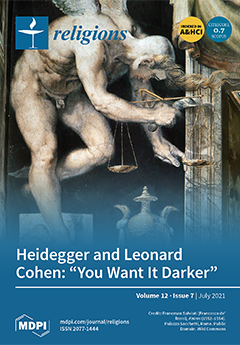The inspiration to write this article was provided by the assessment made by Joseph Ratzinger/Benedict XVI: man of the Western civilization is undergoing a deep spiritual crisis. Therefore, conversion, a breakthrough, or spiritual renewal is absolutely necessary. Without this renewal, humanity will become
[...] Read more.
The inspiration to write this article was provided by the assessment made by Joseph Ratzinger/Benedict XVI: man of the Western civilization is undergoing a deep spiritual crisis. Therefore, conversion, a breakthrough, or spiritual renewal is absolutely necessary. Without this renewal, humanity will become a victim of its own thinking, wanting and acting. As I search for a philosophical description of the breakthrough postulated by Benedict XVI, I refer to the original philosophical and religious thought of Polish philosopher Józef Tischner, who presents the question of the breakthrough at the anthropological-axiological level, where he exposes the issue of interpersonal correlation. The basis for the permanent existence of this correlation is man’s ethical awareness grounded in the ethic of dialogue. This grounding is particularly important, because it is a guarantee for overcoming internal and external threats to the existence of a religious community. Tischner presents the issue of this grounding against the background of the secularization of Western society. By distinguishing relative secularization from radical secularization, Tischner provides an insightful analysis of the phenomenon of the apparent and the true
sacrum. For a real breakthrough, only the true
sacrum, which Tischner believes to appear at the level of the Christian
sanctum, is of primary importance. He understands
sanctum as holiness grounded in goodness. It is holiness that is the real key to overcoming man’s multiple crises at the level of his thinking and religious life, at the level of both his private and social life. The presence of
sanctum in human life constitutes, in Tischner’s view, the very core of the breakthrough and an expression of the important significance of religion in both individual and social human life. According to Tischner, it is owing to the presence of
sanctum, i.e., that which is absolutely good, that man does not have to fall into the trap of post-secular thinking. For post-secularity, as Tischner believes, seeks ways to overcome the tension between the secularized world and the world of religion only in renouncing, for epistemic reasons, the absolutization of secular reason. In his opinion, however, this is not enough for believers and non-believers to follow a common path of cultivating the heritage of universal principles and values, historically expressed mainly in religious life. Only the capacity for selfless kindness can serve as the basic condition for both believers and non-believers to understand and preserve this heritage.
Full article





